TOYOTA xA 2006 Owners Manual (in English)
Manufacturer: TOYOTA, Model Year: 2006, Model line: xA, Model: TOYOTA xA 2006Pages: 250, PDF Size: 4.2 MB
Page 141 of 250
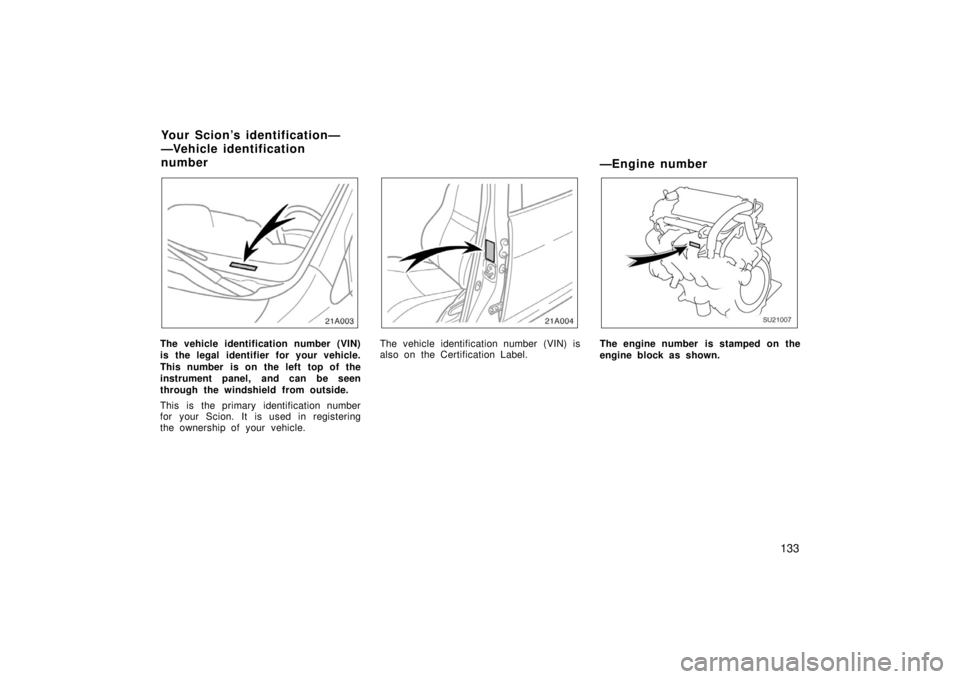
133
The vehicle identification number (VIN)
is the legal identifier for your vehicle.
This number is on the left top of the
instrument panel, and can be seen
through the windshield from outside.
This is the primary identification number
for your Scion. It is used in registering
the ownership of your vehicle.The vehicle identification number (VIN) is
also on the Certification Label.
—Engine number
SU21007
The engine number is stamped on the
engine block as shown.
Your Scion’s identification—
—Vehicle identification
number
Page 142 of 250
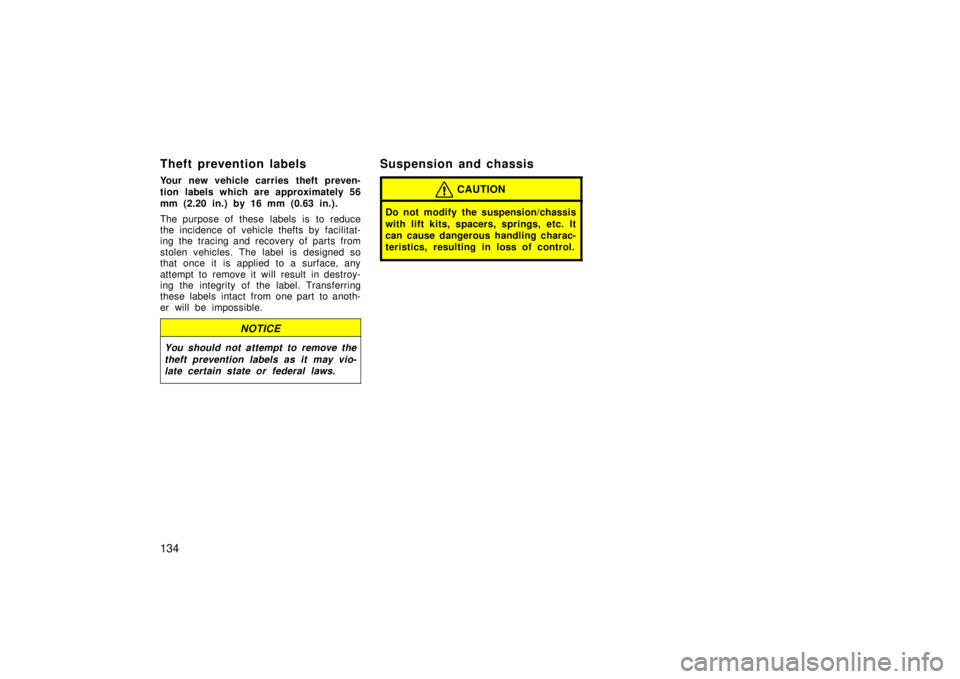
134
Theft prevention labels
Your new vehicle carries theft preven-
tion labels which are approximately 56
mm (2.20 in.) by 16 mm (0.63 in.).
The purpose of these labels is to reduce
the incidence of vehicle thefts by facilitat-
ing the tracing and recovery of parts from
stolen vehicles. The label is designed so
that once it is applied to a surface, any
attempt to remove it will result in destroy-
ing the integrity of the label. Transferring
these labels intact from one part to anoth-
er will be impossible.
NOTICE
You should not attempt to remove the
theft prevention labels as it may vio-
late certain state or federal laws.
Suspension and chassis
CAUTION
Do not modify the suspension/chassis
with lift kits, spacers, springs, etc. It
can cause dangerous handling charac-
teristics, resulting in loss of control.
Page 143 of 250
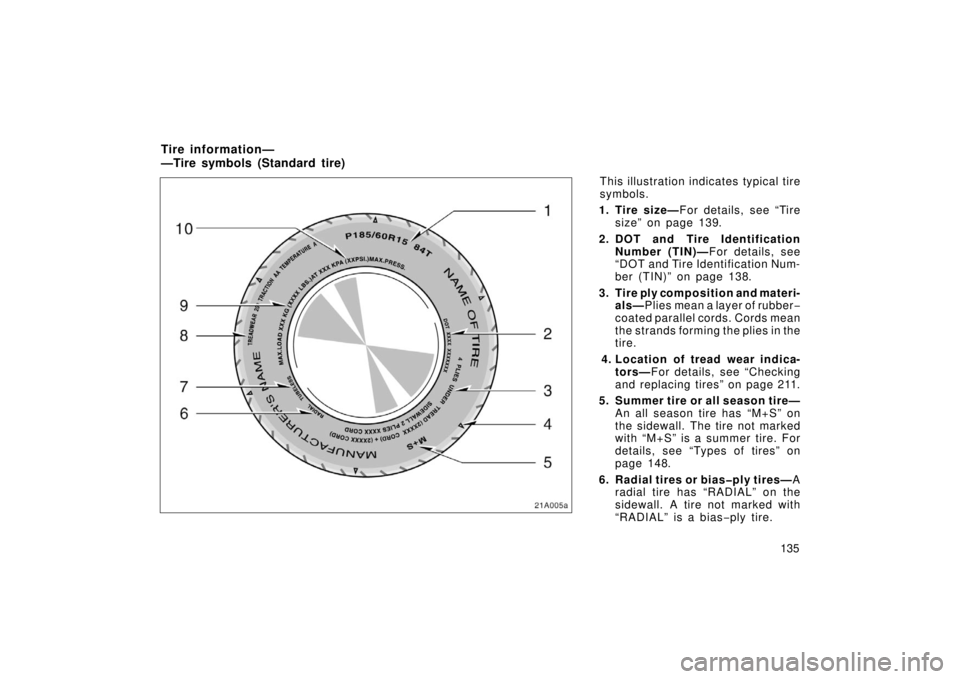
135
This illustration indicates typical tire
symbols.
1. Tire size— For details, see “Tire
size” on page 139.
2. DOT and Tire Identification Number (TIN)— For details, see
“DOT and Tire Identification Num-
ber (TIN)” on page 138.
3. Tire ply composition and materi- als— Plies mean a layer of rubber −
coated parallel cords. Cords mean
the strands forming the plies in the
tire.
4. Location of tread wear indica- tors— For details, see “Checking
and replacing tires” on page 211.
5. Summer tire or all season tire— An all season tire has “M+S” on
the sidewall. The tire not marked
with “M+S” is a summer tire. For
details, see “Types of tires” on
page 148.
6. Radial tires or bias�ply tires— A
radial tire has “RADIAL” on the
sidewall. A tire not marked with
“RADIAL” is a bias −ply tir e.
Tire information—
—Tire symbols (Standard tire)
21A005a
Page 144 of 250

136
7. “TUBELESS” or “TUBE TYPE”
—A tubeless tire does not have a
tube inside the tire and air is direct-
ly filled in the tire. A tube type tire
has a tube inside the tire and the
tube maintains the air pressure.
8. Uniform tire quality grad- ing— For details, see “Uniform tire
quality grading” that follows.
9. Load limit at maximum cold tire inflation pressure— For details,
see “Checking and replacing tires”
on page 211.
10. Maximum cold tire inflation pressure— This means the pres-
sure to which a tire may be in-
flated. For recommended cold tire
inflation pressure, see “Tires” on
page 233.
Page 145 of 250
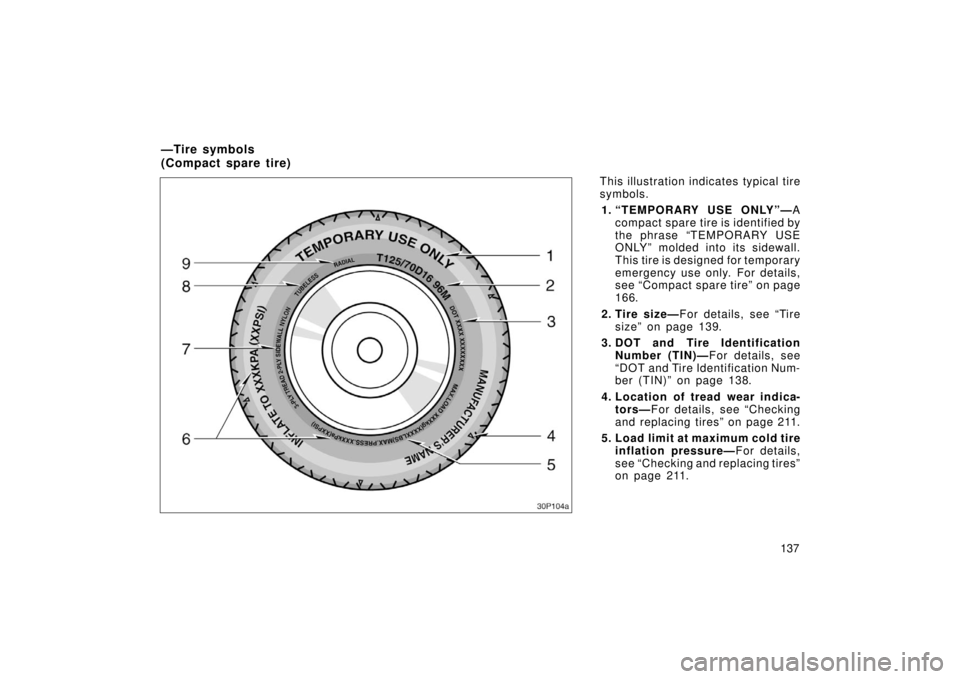
137
This illustration indicates typical tire
symbols.
1. “TEMPORARY USE ONLY”— A
compact spare tire is identified by
the phrase “TEMPORARY USE
ONLY” molded into its sidewall.
This tire is designed for temporary
emergency use only. For details,
see “Compact spare tire” on page
166.
2. Tire size— For details, see “Tire
size” on page 139.
3. DOT and Tire Identification Number (TIN)— For details, see
“DOT and Tire Identification Num-
ber (TIN)” on page 138.
4. Location of tread wear indica- tors— For details, see “Checking
and replacing tires” on page 211.
5. Load limit at maximum cold tire inflation pressure— For details,
see “Checking and replacing tires”
on page 211.
— Tire symb o ls
(Compact spare tire)
30p104a
Page 146 of 250
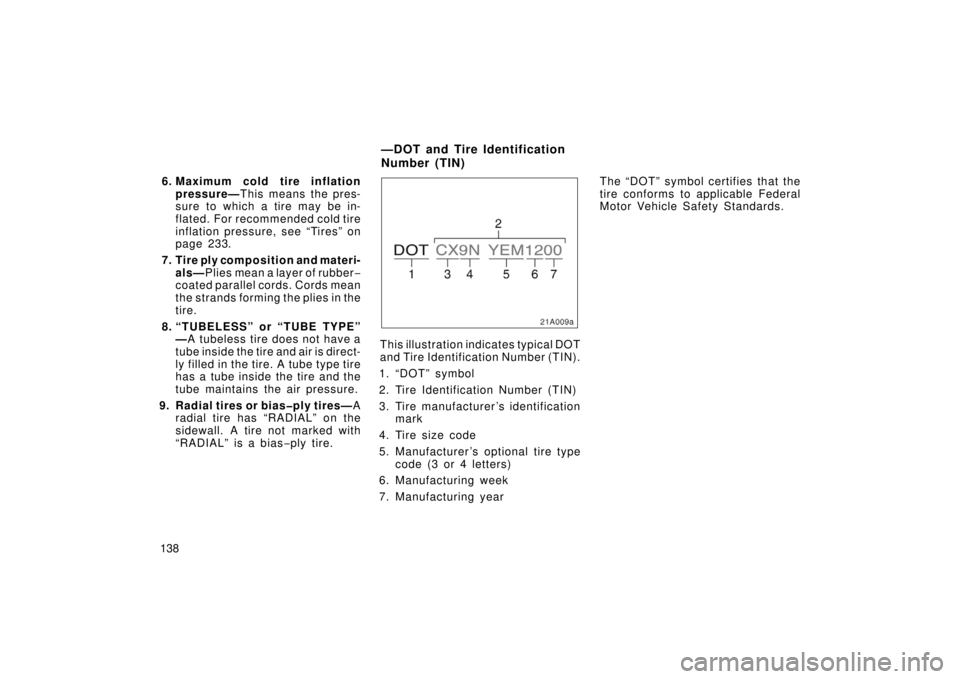
1386. Maximum cold tire inflation
pressure— This means the pres-
sure to which a tire may be in-
flated. For recommended cold tire
inflation pressure, see “Tires” on
page 233.
7. Tire ply composition and materi- als— Plies mean a layer of rubber −
coated parallel cords. Cords mean
the strands forming the plies in the
tire.
8. “TUBELESS” or “TUBE TYPE” —A tubeless tire does not have a
tube inside the tire and air is direct-
ly filled in the tire. A tube type tire
has a tube inside the tire and the
tube maintains the air pressure.
9. Radial tires or bias�ply tires— A
radial tire has “RADIAL” on the
sidewall. A tire not marked with
“RADIAL” is a bias −ply tir e.
21A009a
This illustration indicates typical DOT
and Tire Identification Number (TIN).
1. “DOT” symbol
2. Tire Identification Number (TIN)
3. Tire manufacturer ’s identification mark
4. Tire size code
5. Manufacturer ’s optional tire type code (3 or 4 letters)
6. Manufacturing week
7. Manufacturing year The “DOT” symbol certifies that the
tire conforms to applicable Federal
Motor Vehicle Safety Standards.
—DOT and Tire Identification
Number (TIN)
Page 147 of 250
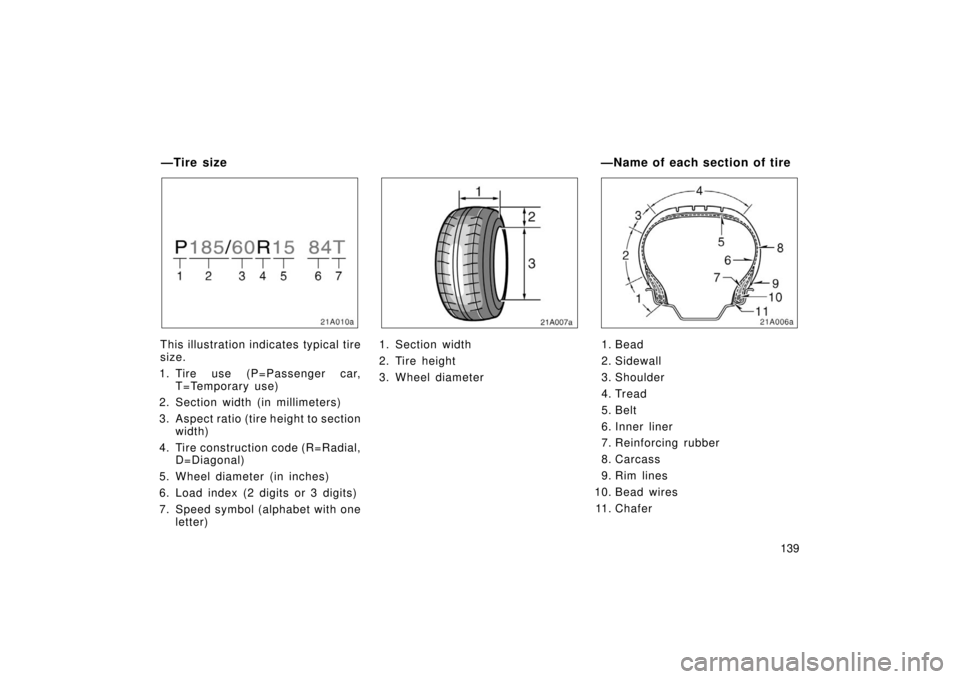
139
21A010a
This illustration indicates typical tire
size.
1. Tire use (P=Passenger car, T=Temporary use)
2. Section width (in millimeters)
3. Aspect ratio (tire height to section width)
4. Tire construction code (R=Radial, D=Diagonal)
5. Wheel diameter (in inches)
6. Load index (2 digits or 3 digits)
7. Speed symbol (alphabet with one letter)
21A007a
1. Section width
2. Tire height
3. Wheel diameter
21A006a
1. Bead
2. Sidewall
3. Shoulder
4. Tread
5. Belt
6. Inner liner
7. Reinforcing rubber
8. Carcass
9. Rim lines
10. Bead wires 11. Chafer
—Tire size —Name of each section of tire
Page 148 of 250

140
—Uniform tire quality grading
This information has been prepared
in accordance with regulations issued
by the National Highway Traffic Safe-
ty Administration of the U.S. Depart-
ment of Transportation. It provides
the purchasers and/or prospective
purchasers of Scion vehicles with in-
formation on uniform tire quality grad-
ing.
Your Scion dealer will help answer
any questions you may have as you
read this information.
DOT quality grades—All passenger
vehicle tires must conform to Fed-
eral Safety Requirements in addi-
tion to these grades. Quality
grades can be found where appli-
cable on the tire sidewall between
tread shoulder and maximum sec-
tion width.
For example:
Treadwear 200 Traction AA
Temperature ATreadwear—
The treadwear grade is
a comparative rating based on the
wear rate of the tire when tested un-
der controlled conditions on a speci-
fied government test course. For ex-
ample, a tire graded 150 would wear
one and a half (1 −1/2) times as well
on the government course as a tire
graded 100. The relative performance
of tires depends upon the actual
conditions of their use, however, and
may depart significantly from the
norm due to variations in driving hab-
its, service practices and differences
in road characteristics and climate. Traction AA, A, B, C—
The traction
grades, from highest to lowest, are
AA, A, B, and C, and they represent
the tire’s ability to stop on wet pave-
ment as measured under controlled
conditions on specified government
test surfaces of asphalt and concrete.
A tire marked C may have poor trac-
tion performance.
Warning: The traction grade assigned
to this tire is based on braking
(straight ahead) traction tests and
does not include cornering (turning)
traction.
Page 149 of 250

141
Temperature A, B, C—
T he tem per a-
ture grades are A (the highest), B,
and C, representing the tire’s resis-
tance to the generation of heat and
its ability to dissipate heat when
tested under controlled conditions on
a specified indoor laboratory test
wheel. Sustained high temperature
can cause the material of the tire to
degenerate and reduce tire life, and
excessive temperature can lead to
sudden tire failure. The grade C cor-
responds to a level of performance
which all passenger car tires must
meet under the Federal Motor Vehicle
Safety Standard No. 109. Grades B
and A represent higher levels of per-
formance on the laboratory test wheel
than the minimum required by law.
Warning: The temperature grades for
this tire are established for a tire that
is properly inflated and not over-
loaded. Excessive speed, underinfla-
tion, or excessive loading, either sep-
arately or in combination, can cause
heat buildup and possible tire failure.
Page 150 of 250

142Ti r e relat ed ter m
Meaning
Cold tire inflation pressure
tire inflation pressure when the vehicl
e has been parked for at leas t 3 hour s
or more, or it has not been driven more than 1.5 km or 1 mile under that
condition
Maximum inflation pressurethe maximum cold inflation pressure to which a tire may be inflated and it is
shown on the sidewall of the tire
Recommended inflation pressurecold tire inflation pressure recommended by a manufacturer
Accessory weight
the combined weight (in excess of those standard items which may be replaced)
of automatic transmission, power steering, power brakes, power windows, pow-
er seats, radio, and heater, to the extent that these items are available as
factory −installed equipment (whether installed or not)
Curb weight
the weight of a motor vehicle with standard equipment including the maximum
capacity of fuel, oil, and coolant, and, if so equipped, air conditioning and addi-
tional weight optional engine
Maximum loaded vehicle weight
t he sum of —
(a) curb weight;
(b) accessory weight;
(c) vehicle capacity weight; and
(d) production options weight
Normal occupant weight68 kg (150 lb.) times the number of occupants specified in the second column
of Table 1 that follows
—Glossary of tire terminology